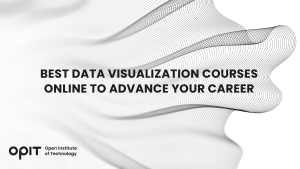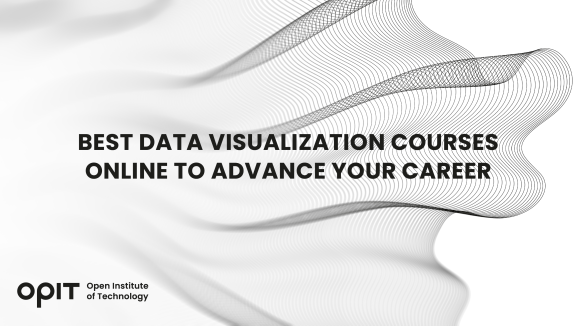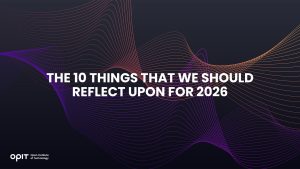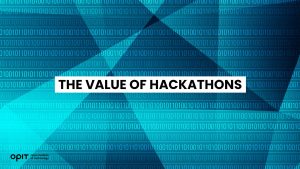

Data visualization is an essential skill in all areas of business and industry. The ability to take complex data and present it in a simple way speeds up decision-making and increases business agility. No wonder so many tech professionals are considering upskilling themselves with an online data visualization course.
If you’re a graduate looking for the best data visualization courses online, you might consider the Open Institute of Technology (OPIT). OPIT offers a Master’s Degree (MSc) in Responsible AI that includes a full segment on data analytics and visualization within the context of AI and other data sciences.
Let’s take a look at more reasons to start an online data visualization course and the benefits it can bring.
The Power of Data Visualization
Businesses thrive on high-quality data. The world generates 463 exabytes of data daily, much of which flows through busy organizations. While experienced data scientists may be able to gain snapshot analyses from complex datasets, most people can’t. That’s where data visualization comes into its own.
A data science and visualization course teaches students how to collect, cleanse, and analyze data before visualization transformations. This includes turning data into graphs, maps, or other graphic displays.
Data visualization turns raw data into usable insights. These insights allow business leaders to take action, change marketing campaigns, budget allocations, or even hiring policies. The ability to quickly see what needs to change allows businesses to edge ahead of competitors.
Choosing the Right Data Visualization Course
The best courses for data visualization teach these skills without taking busy IT professionals or data managers away from their current careers. Online courses provide flexibility and accessibility, allowing learners to study when it’s convenient for them.
Consider the following factors when choosing data visualization online courses:
- Duration
- Topics covered
- Support and student community
- Accreditation
- Career-aligned skills
- Certification
OPIT’s online courses cater to professionals with busy schedules by providing a high-level curriculum entirely online. OPIT is also fully EU-accredited and provides students with internationally recognized qualifications.
The Best Data Visualization Online Courses
Choosing data analysis and visualization courses online is tricky with so many options available. Here are five of the best currently available. Always take the above points on choosing the best online data visualization course into account before committing to a program of study.
Data Visualization with Python
This course from IBM via the Coursera platform looks exclusively at how to use the Python programming language for data analysis and visualization. Classed as intermediate level, some basic data management and programming knowledge is assumed. Tech professionals may find this course useful for upskilling themselves and learning some foundational data visualization skills.
Provider: IBM
Duration: 19 hours
Fees: $39 per month which includes access to other related courses
Qualification Gained: Digital course-specific certificate
Data Visualization Nanodegree Program
Udacity presents this “nanodegree” as a collection of four courses. The program introduces and then expands on data visualization and storytelling. Students will learn design principles, how to use Tableau, dashboard planning and design, and how to build a data story. There are also topics on data limitations and biases.
Provider: Udacity
Duration: Five months
Fees: Either month-to-month at $249 or four months for $846 (minimum $1,095)
Qualification Gained: Udacity Certificate of Achievement
Data Storytelling for Business
One of the few hybrid courses on our list, this storytelling and data visualization course does offer the option for an in-person class. However, you can also complete the program over two virtual seminars, each lasting three hours. This short course focuses on the three “Ds” of data storytelling: Define, Draft, Display, De-clutter, and Direct. It focuses primarily on helping business professionals deliver more effective, impactful presentations.
Provider: StoryIQ
Duration: One day in-person or six hours online with a follow-up session after four weeks
Fees: $230
Qualification Gained: Digital certificate of completion
Hands-On Tableau Training for Data Science
Tech professionals who want to get more out of Tableau could sign up for this software-specific data visualization online course. Tableau is a popular platform for creating data dashboards and is often used for business intelligence (BI) purposes. Students will learn about different types of visuals including charts, maps, graphs, and tables, with table calculations. There’s also a deeper dive into data aggregation and granularity.
Provider: Udemy
Duration: There are nine hours of lectures to complete at your own pace
Fees: $99 for this course but the platform has various subscription options available
Qualification Gained: Udemy Certificate of Completion
OPIT MSc in Responsible AI
For those searching for the best courses on data visualization for graduates, a master’s degree is usually the next step. OPIT’s Master’s Degree in Responsible Artificial Intelligence covers multiple AI-related topics, including data analysis and visualization. Students learn about the challenges associated with handling large, complex datasets. They cover data preprocessing, cleaning, and using that data to tell effective stories.
Provider: OPIT (EU-accredited higher education provider)
Duration: The fast-track option takes 12 months and the standard pathway takes 18 months
Fees: €6,500 — scholarships and discounts are available
Qualification Gained: Globally recognized MSc, equivalent to a Level 7 qualification worth 90-120 ECTS
Key Components of a Comprehensive Data Visualization Course
How do you choose which course is right for you? Your search should start by deciding why you want to take a data science and visualization course. If it’s simply for the joy of studying and learning new skills, one of the shorter courses might suit you. However, if you’re a graduate working in tech already, upskilling yourself will probably require investing in an MSc or similar-level course.
Here are some advanced topics tech professionals to look out for:
- Exploratory data analysis
- Crafting data pipelines in multiple programming languages
- Handling intricate datasets
- Data cleansing, processing, and integration
- Creating visualizations from multiple streams of data
- Linear and nonlinear dimensionality reduction
These skills can help you get ahead in your career by giving you the tools to work with data in any organization. Advanced data science skills are transferable and system agnostic, allowing you to apply for more roles at higher salaries.
OPIT’s Approach to Data Visualization Education
Why study with OPIT? Our unique teaching methods and course structure are deliberately career-aligned. We want to support busy professionals moving forward on their chosen trajectory. The best data visualization courses should allow you to work at your own pace, around your existing commitments.
Our teaching faculty is packed with top-notch academic leaders. We believe that choosing the right team makes the differences between good and great education. On the OPIT MSc in Responsible AI course, for example, you get to learn from Panagiota Katsikouli, a computer science researcher at the University of Copenhagen. Other top-flight faculty members include Pierluigi Casale, a principal data officer for TomTom, and Raj Dasgupta, an AI/ML research scientist at US Naval Research Laboratory.
Your course structure will include a balance of theory and practical hands-on activities. Students start with foundational theory, and then quickly learn how to apply this in real-life situations. For data visualization, expect to start with collating and cleansing data and move on to advanced analysis and presentation techniques. All courses are competency-based, with no final exams to stress about. You acquire new skills as you progress, making these courses ideal for career-minded tech professionals.
Integrating Data Visualization With Other Data Science Skills
Data visualization isn’t a standalone skill. That’s why integrating it with other data science topics such as AI and machine learning is essential. You want a skillset you can apply within your career, which means learning how it relates to various other aspects of data management. Data analysis is normally a primary step in effective visualization. However, analysis isn’t possible without first collating and processing data. The best data analysis and visualization online courses should naturally teach students how data visualization works with other data skills.
OPIT’s courses achieve this by empowering students to create industry-relevant data dashboards, pipelines, and stories. The MSc course culminates with a thesis, which is a research endeavor related to the student’s career ambitions. Learners are also encouraged to pursue internships to practice their skills and gain experience to help them achieve their career goals.
Make Sure You Choose the Right Online Data Visualization Course for Your Career
Choosing the best online data visualization course is essential to optimize your time and learn relevant skills. Make sure you understand the time commitment, cost, and qualifications you’ll gain at the end.
It’s also important to make sure you choose a trusted, accredited educational provider. OPIT’s accredited online programs could take you one step closer to your professional goals.
Explore the OPIT course offerings for more information on how we can further your tech career.
Related posts

2025 has come to a close, with 2026 already underway. There are many exciting events ahead and future milestones to aim for and look forward to. But it’s also the ideal time to look back over the last 12 months, exploring the most notable achievements we’ve made, lessons we’ve learned, and important moments to reflect on as the new year continues for OPIT’s staff, students, and broader community.
1. Student Commitment
Studying isn’t always easy. It involves long days, and even long evenings sometimes, with a seemingly never-ending series of tasks to accomplish and goals to aim for. It can take a lot out of even the most hard-working and dedicated individuals.
Yet, despite the hardships and challenges, OPIT students demonstrated remarkable resilience, continuous curiosity, and indefatigable determination throughout 2025. Looking back on the year, students at all levels of the OPIT community should feel proud and celebrate their accomplishments.
2. Podcast Launch
2025 saw a lot of new arrivals at OPIT, with fresh projects and innovations arriving on the scene. Chief among them was the OPIT EDGE Podcast, an exciting addition to the institute’s ever-expanding multimedia offerings.
There have already been several episodes of the podcast for students and technology enthusiasts in general to enjoy, with the first episode of this student-driven project involving an in-depth discussion with industry expert Matteo Zangani on the potential of quantum AI technology.
3. Success Stories
While many new students have joined the OPIT ranks in 2025 and will also do so in 2026, others have now achieved their educational objectives and are already moving on to the next exciting steps and chapters in their personal and professional lives.
There are so many inspiring success stories from the last 12 months, it’s impossible to list them all. But just one notable example has to be Maria Brilaki, who recently concluded her Master’s in Responsible AI, defending a powerful thesis related to non-invasive glucose monitoring through near-infrared spectroscopy and machine learning.
4. Graduation in Malta
2025 was a big year of firsts for OPIT, including the institute’s first official graduation ceremony, which took place on March 8 at a grand ceremony in Malta, honoring the achievements of dozens of applied data science and AI graduates.
The hybrid event was open to both in-person and virtual attendees, bringing together members of the OPIT community from across the world. It was a huge moment for the graduates themselves and a thrilling milestone for OPI – a testament to all the hard work that has gone into building this institute.
5. OPIT AI Copilot
Artificial intelligence is the technology of the moment, and OPIT isn’t just dedicated to teaching the next-generation of technology leaders how to work with AI responsibly and efficiently; it’s also interested in harnessing the powers and potential of AI to improve its educational offerings, too.
This culminated in the development and release of OPIT AI Copilot in 2025. This groundbreaking AI tool now provides real-time, personalized learning support, along with contextual assistance, and is available on a round-the-clock basis for students to turn to, as and when they feel the need.
6. Hackathons
2025 also saw OPIT students and faculty take more active roles in various events, including hackathons. In November, for example, OPIT got involved with the 6th edition of the ESCP Hackathon, with several students entering as developers.
This was an exciting and unique opportunity for those students to meet up in person, put the skills they’ve honed during their time at OPIT to the test in a challenging environment, and learn from one another. OPIT will surely participate in more hackathons in the years to come, so stay tuned for more details on upcoming events and how you can play your part.
7. Strengthening Collaboration
From day one, OPIT has focused on building a strong network of established technology and business partners, opening doors and providing opportunities for both education and employment for its students.
This continued throughout 2025, with OPIT strengthening its connections with a number of world-leading organizations, including Accenture, AWS, Hype, Buffetti, and more. Through events like hackathons, career fairs, and more, OPIT makes the most of its ever-expanding and increasingly impressive professional network.
8. Online Career Fair
Another big first for 2025 was the inaugural OPIT Online Career Fair, an event that was held on November 19 and 20, with more than a dozen established and emerging companies from around the world in attendance, including the likes of Deloitte, Tinexta Cyber, Datapizza, RWS Group, Planet Farms, and Nesperia Group.
The only nature of this event ensured that students all enjoyed equal access, no matter where they were based, and everyone was able to hear from industry experts and enjoy the unique array of opportunities on offer, forging their own connections and learning more about brands they might like to work with or for in the future.
9. Education Innovation
OPIT has always been about innovating, delivering newer and smarter ways to learn for students across the globe, no matter their background, budget, or social class. And the institute has continually innovated over the course of 2025, helping students learn skills and broaden their knowledge efficiently and intuitively.
As we enter 2026, OPIT’s innovation is set to be on full display once more, with no less than two new courses for new applicants to choose from: AI-Driven Software Development (Elective) and Business Intelligence and Decision Making (Elective).
10. The Power of the OPIT Community
Perhaps the crowning achievement for OPIT in 2025 was the demonstrable success of not just individual students or faculty members, but the entire OPIT community, as a whole. Everyone, from alumni to new students and seasoned staff members, played their part in the institute’s success, paving the way for more great things and major milestones in 2026 and beyond.
As OPIT Rector and former Italian Minister of Education, Francesco Profumo, puts it:
“What inspires me most is the mindset of our students: forward-looking, responsible, and driven by a desire not just to succeed, but to contribute. Their dedication reminds us why education remains one of the most powerful forces for shaping the future.”

Bring talented tech experts together, set them a challenge, and give them a deadline. Then, let them loose and watch the magic happen. That, in a nutshell, is what hackathons are all about. They’re proven to be among the most productive tech events when it comes to solving problems and accelerating innovation.
What Is a Hackathon?
Put simply, a hackathon is a short-term event – often lasting just a couple of days, or sometimes even only a matter of hours – where tech experts come together to solve a specific problem or come up with ideas based on a central theme or topic. As an example, teams might be tasked with discovering a new way to use AI in marketing or to create an app aimed at improving student life.
The term combines the words “hack” and “marathon,” due to how participants (hackers or programmers) are encouraged to work around-the-clock to create a prototype, proof-of-concept, or new solution. It’s similar to how marathon runners are encouraged to keep running, putting their skills and endurance to the test in a race to the finish line.
The Benefits of Hackathons
Hackathons provide value both for the companies that organize them and the people who take part. Companies can use them to quickly discover new ideas or overcome challenges, for example, while participants can enjoy testing their skills, innovating, networking, and working either alone or as part of a larger team.
Benefits for Companies and Sponsors
Many of the world’s biggest brands have come to rely on hackathons as ways to drive innovation and uncover new products, services, and opportunities. Meta, for example, the brand behind Facebook, has organized dozens of hackathons, some of which have led to the development of well-known Facebook features, like the “Like” button. Here’s how hackathons help companies:
- Accelerate Innovation: In fast-moving fields like technology, companies can’t always afford to spend months or years working on new products or features. They need to be able to solve problems quickly, and hackathons create the necessary conditions to deliver rapid success.
- Employee Development: Leading companies like Meta have started to use annual hackathons as a way to not only test their workforce’s skills but to give employees opportunities to push themselves and broaden their skill sets.
- Internal Networking: Hackathons also double up as networking events. They give employees from different teams, departments, or branches the chance to work with and learn from one another. This, in turn, can promote or reinforce team-oriented work cultures.
- Talent Spotting: Talents sometimes go unnoticed, but hackathons give your workforce’s hidden gems a chance to shine. They’re terrific opportunities to see who your best problem solvers and most creative thinkers at.
- Improving Reputation: Organizing regular hackathons helps set companies apart from their competitors, demonstrating their commitment to innovation and their willingness to embrace new ideas. If you want your brand to seem more forward-thinking and innovative, embracing hackathons is a great way to go about it.
Benefits for Participants
The hackers, developers, students, engineers, and other people who take part in hackathons arguably enjoy even bigger and better benefits than the businesses behind them. These events are often invaluable when it comes to upskilling, networking, and growing, both personally and professionally. Here are some of the main benefits for participants, explained:
- Learning and Improvement: Hackathons are golden opportunities for participants to gain knowledge and skills. They essentially force people to work together, sharing ideas, contributing to the collective, and pushing their own boundaries in pursuit of a common goal.
- Networking: While some hackathons are purely internal, others bring together different teams or groups of people from different schools, businesses, and places around the world. This can be wonderful for forming connections with like-minded individuals.
- Sense of Pride: Everyone feels a sense of pride after accomplishing a project or achieving a goal, but this often comes at the end of weeks or months of effort. With hackathons, participants can enjoy that same satisfying feeling after just a few hours or a couple of days of hard work.
- Testing Oneself: A hackathon is an amazing chance to put one’s skills to the test and see what one is truly capable of when given a set goal to aim for and a deadline to meet. Many participants are surprised to see how well they respond to these conditions.
- Boosting Skills: Hackathons provide the necessary conditions to hone and improve a range of core soft skills, such as teamwork, communication, problem-solving, organization, and punctuality. By the end, participants often emerge with more confidence in their abilities.
Hackathons at OPIT
The Open Institute of Technology (OPIT) understands the unique value of hackathons and has played its part in sponsoring these kinds of events in the past. OPIT was one of the sponsors behind ESCPHackathon 6, for example, which involved 120 students given AI-related tasks, with mentorship and guidance from senior professionals and developers from established brands along the way.
Marco Fediuc, one of the participants, summed up the mood in his comments:
“The hackathon was a truly rewarding experience. I had the pleasure of meeting OPIT classmates and staff and getting to know them better, the chance to collaborate with brilliant minds, and the opportunity to take part in an exciting and fun event.
“Participating turned out to be very useful because I had the chance to work in a fast-paced, competitive environment, and it taught me what it means to stay calm and perform under pressure… To prospective Computer Science students, should a similar opportunity arise, I can clearly say: Don’t underestimate yourselves!”
The new year will also see the arrival of OPIT Hackathon 2026, giving more students the chance to test their skills, broaden their networks, and enjoy the one-of-a-kind experiences that these events never fail to deliver. This event is scheduled to be held February 13-15, 2026, and is open to all OPIT Bachelor’s and Master’s students, along with recent graduates. Interested parties have until February 1 to register.
Have questions?
Visit our FAQ page or get in touch with us!
Write us at +39 335 576 0263
Get in touch at hello@opit.com
Talk to one of our Study Advisors
We are international
We can speak in:


